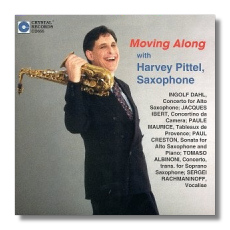
The Internet's Premier Classical Music Source
Related Links
- Latest Reviews
- More Reviews
-
By Composer
-
Collections
DVD & Blu-ray
Books
Concert Reviews
Articles/Interviews
Software
Audio
Search Amazon
Recommended Links
Site News
 CD Review
CD Review
Moving Along

Works and Transcriptions for Saxophone & Piano
- Paul Creston: Sonata for Alto Saxophone
- Ingolf Dahl: Concerto for Saxophone
- Sergei Rachmaninoff: Vocalise
- Jacques Ibert: Concerto da Camera
- Paule Maurice: Tableaux de Provence
- Tomaso Albinoni: Concerto "Saint Marc"
Harvey Pittel, saxophone
Jeff Helmer, piano
Crystal Records CD 655
The saxophone sonata is the rarest of birds, so I was glad to hear this collection of pieces by known and unknown composers, and even a transcription of a baroque composer. The selections are richly varied. Paul Creston's Sonata for Alto Saxophone (1937) has a deceptively simple style, yet embedded in its languid rhythms are complex harmonic passages. His debt to George Gershwin quivers underneath, but doesn't poke through the work. Ingolf Dahl's Concerto for Alto Saxophone (1953), later adapted to a sonata (but never renamed) is full of dotted rhythms, stray dissonances, and meandering themes. Its Passacaglia may be moody, but it lacks heart. Except for the perky rondo march in III, I don't care much for this work. I find it cold and formalistic, as if Dahl is imitating Igor Stravinsky (whom he admired) on an off-day. Saxophonist Harvey Pittel's transcription of Sergei Rachmaninoff's famous Vocalise works beautifully. Pittel holds its gushy romanticism in check with his splendid sense of timing and articulation. Its portion is just small enough (3.5 minutes) to leave you hungering for more. Jacques Ibert's Concertino da Camera (1935), originally written for orchestral accompaniment, is the most engaging piece on this disc. The harmonies are oval and opulent, inventive yet not chaotic. The rhapsodic Larghetto prepared me for the expressive Animato molto, with its naughty virtuosic strains. Toward the end, there is even a jazz-like cadenza. Helmer plays a charming, not-too-quirky piano, particularly during the sparkling coda. This piece has inspired me to obtain one of the half dozen orchestral versions listed in the Schwann catalogue. Paule Maurice's Tableaux de Provence is sprightly and languid, terpsichorean and funereal. A series of nostalgic musical snapshots of rural France, it encompasses many aspects of a deceptively simple life. I particularly like the minute-long La Bohemienne, which hoisted me from my desk and threw me into a mad gigue with my lover. That and the buzzing, dizzy Le Cabridan sent my soul whirling. Record companies of the world, please give us more of this composer!
There has to be something perverse, even sacrilegious, about adapting Tomaso Albinoni's Eighteenth Century Concerto "Saint Marc" for the saxophone. Nevertheless, Pittel does it completely seriously, from the reverential Grave in I to the sunny Venetian strains in IV. Such a rendition may alarm the purists, but so what? I much prefer it to the creaky violin/continuo version.
Copyright © 1998, Peter Bates


















